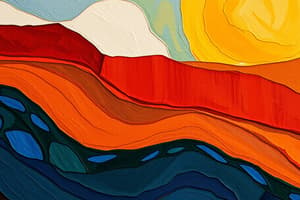Podcast
Questions and Answers
What is the minimum temperature required for rocks to melt?
What is the minimum temperature required for rocks to melt?
- 800 degrees Celsius
- 700 degrees Celsius
- 500 degrees Celsius
- 600 degrees Celsius (correct)
What happens to the magma as it rises to the Earth's surface?
What happens to the magma as it rises to the Earth's surface?
- It solidifies immediately
- It disappears into the Earth's crust
- It coalesce into larger volumes and becomes part of a larger magma chamber (correct)
- It cools and solidifies slowly
What is necessary for rocks to melt?
What is necessary for rocks to melt?
- At least one of the following: high temperature, low pressure, or presence of volatiles (correct)
- Only high temperature
- Only low pressure
- Only presence of volatiles
Where are the melts commonly found?
Where are the melts commonly found?
What type of rocks are formed when magma is trapped underneath the surface and slowly cools?
What type of rocks are formed when magma is trapped underneath the surface and slowly cools?
What is the primary difference between volcanic and plutonic rocks?
What is the primary difference between volcanic and plutonic rocks?
What is characterized by its light-colored, low density, and vesicle-rich appearance?
What is characterized by its light-colored, low density, and vesicle-rich appearance?
What is the term for any large igneous body that cools and solidifies near the Earth's surface?
What is the term for any large igneous body that cools and solidifies near the Earth's surface?
What is the reason for the fine-grained or glassy texture of volcanic rocks?
What is the reason for the fine-grained or glassy texture of volcanic rocks?
What is the primary composition of granite?
What is the primary composition of granite?
What is a characteristic of batholiths?
What is a characteristic of batholiths?
What is the orientation of dikes?
What is the orientation of dikes?
What is an example of a sill?
What is an example of a sill?
What is a common composition of batholiths?
What is a common composition of batholiths?
What can deform the original orientation of intrusive bodies?
What can deform the original orientation of intrusive bodies?
Study Notes
Igneous Rock Definition
- Igneous rocks are formed when molten material called magma cools and solidifies.
- There are three types of rocks: igneous, sedimentary, and metamorphic rocks.
Igneous Rock Formation
- Magma forms in the upper mantle, where the temperature is between 600 to 1300 degrees Celsius.
- Rocks can melt if the temperature is at least near the temperature in the upper mantle, the pressure decreases, or volatiles like water are present.
- Magma can rise to the Earth's surface through boundaries between tectonic plates or hot spots.
Plutonic vs. Volcanic Rocks
- Plutonic rocks are formed when magma is trapped underneath the surface and slowly cools.
- Volcanic rocks are formed when magma is extruded onto the Earth's surface through volcanic vents and fissures as lava.
Volcanic Rocks
- Volcanic rocks are formed when the molten material is extruded onto the Earth's surface or near the surface.
- The rocks formed are also called extrusive rocks.
- Volcanic rocks have a fine-grained or glassy texture and may contain vesicles.
- Examples of volcanic rocks include pumice.
Pumice
- Pumice is formed when lava from a violent eruption quickly cools and solidifies.
- It is an example of extrusive igneous rock.
- Pumice is characterized by its light-colored, low density, and vesicle-rich appearance.
- It is primarily composed of silicon dioxide and some amounts of aluminum oxide.
Plutonic Rocks
- Plutonic rocks, also called intrusive rocks, are formed from magma that did not reach the Earth's surface and are trapped underneath the crust.
- Plutonic rocks cool at a very slow rate and may take thousands or millions of years to solidify.
- They have a coarse-grained texture and can form large crystals that can be easily observed.
- Examples of plutonic rocks include granite.
Granite
- Granite is formed by a viscous felsic magma that slowly cools underneath the Earth's surface.
- It is characterized by its coarse-grained, light-colored crystalline texture.
- Its light color originates from its mineral composition, which includes feldspar, quartz, mica, and amphibole.
- Granite is an example of intrusive igneous rock.
Plutons
- Pluton is a general term for any large igneous body that cools and solidifies near the Earth's surface.
- Plutons can fill and widen existing gaps, forming batholiths, dikes, and sills.
- They are only exposed to the surface when the overlying rocks are eroded.
Batholiths
- Batholiths are irregularly shaped plutons that can reach up to hundreds of kilometers long and several kilometers across.
- They are typically composed of several smaller plutons with the same composition.
- Examples of batholiths include the Sierra Nevada Batholith in California and Pikes Peak granite in Colorado.
Sills and Dikes
- Dikes are formed when magma intrudes on a pre-existing rock body and starts to crystallize as sheet intrusions.
- Dikes are characterized by high angle or near-vertical orientation.
- Sills are formed when magma intrudes horizontally and is parallel to the beds and foliations in the rock.
- Examples of dikes include the Mackenzie dike swarm in the Northwest Territories, Canada and the Spanish Peaks volcanic dikes in Southern Colorado.
- Examples of sills include the Dolerite sills located in Karroo, South Africa.
Studying That Suits You
Use AI to generate personalized quizzes and flashcards to suit your learning preferences.
Description
Learn about the definition and formation of igneous rocks, including how they are created from molten magma and cool down to solidify. Understand the characteristics that distinguish igneous rocks from other types of rocks.




